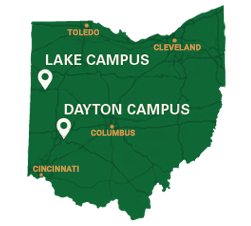New Student Information
On this page:
All Students
Accommodations
To receive accommodations, students must complete a confidential registration process (separate from admissions):
- Complete the online application
- Submit professional documentation of disability, and
- Attend a College Accommodation Planning meeting
Population-Specific Notes
Direct From High School Students
We strongly encourage students to work with their intervention specialists prior to graduation to register with the Office of Disability Services and submit documentation during their senior year of high school.
College Credit Plus (CCP) Students
CCP students taking classes from Wright State University who require disability related accommodations will need to register with ODS and submit documentation to utilize accommodations at the college level. While we will want to see your IEP/504 Plan and ETR, your college accommodations may be different from those you qualified for in high school. Students are encouraged to complete this process BEFORE the CCP class begins so that accommodations are in place.
Transfer Students
Students who received accommodations at their previous college are asked to provide an accommodation letter from the previous school in addition to documentation of their disability.
Graduate Students
Students who received accommodations at their previous college are asked to provide an accommodation letter from the previous school in addition to documentation of their disability.
Medical Students
Students who received accommodations at their previous college are asked to provide an accommodation letter from the previous school in addition to documentation of their disability.
How are High School and College Different?
Transition Guide
For in-depth information on the transition from high school to college, visit the U.S. Department of Education Transition Guide.
Applicable Laws
High School
High school students are accommodated under the Individuals with Disabilities Education Act and Section 504 of the Rehabilitation Act of 1973. Accommodations provided for students are designed to ensure student success.
College
Accommodations at the college level are provided for under the Americans with Disabilities Act and Section 504 of the Rehabilitation Act of 1973 and are designed to provide access to the curriculum.
Documentation of Disability
High School
In the K-12 system (kindergarten through 12th grade), the school system is responsible for identifying students with disabilities.
College
College students must self-identify and provide documentation of their disability.
Instruction, Homework, and Tests
High School
Amongst a wide variety of accommodations in the K-12 system, modification of curriculum, shortening of assignments, or reduction of work might be part of a student's IEP.
College
Accommodations at the college level provide access, but the curriculum, work load, and expectations are the same as students without disabilities.
Parental Role
High School
Parents are highly involved in all aspects of an IEP or 504 Plan and communicate frequently with teachers.
College
Students are entitled to FERPA protections. The student is the only person teachers and ODS can communicate with directly without explicit permission, and teachers and ODS do not regularly communicate regarding a student. If a student has an issue or concern, they must approach the appropriate supports for assistance.
Student Responsibilities
College
As a college student (including CCP students under 18 years of age), the student is responsible for their educational experience. They can choose to register with Disability Services and to utilize accommodations each semester.


